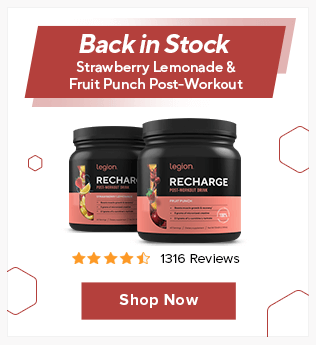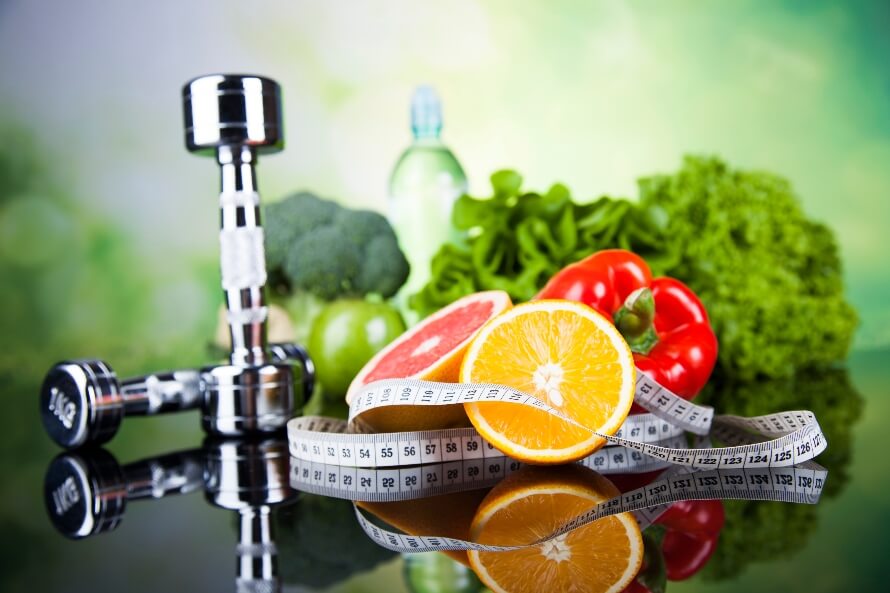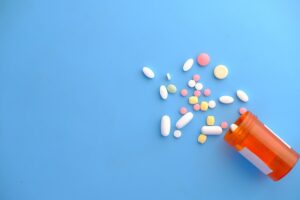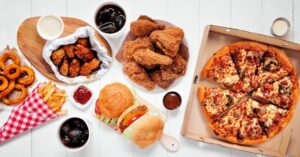Consuming a nutritious diet is like consuming from the fountain of youth: it makes you’re feeling wholesome, comfortable, and important.
Some folks take this to an obsessive excessive, although, and turn out to be possessed by the search to search out the world’s healthiest weight loss plan.
Sadly, when you’re in search of the healthiest weight loss plan on the planet among the many hottest mainstream weight loss plan developments, you’re most likely losing your time.
That’s as a result of too many give attention to limiting or excluding sure meals teams as a substitute of encouraging you to eat others. It’s all “don’t eat this,” and little or no “do eat this, and a few of this carefully.”
Whereas this technique can provide some advantages—particularly if the meals you’re supposed to chop again on are a chief supply of extra energy in your weight loss plan—many instances these restrictions are based mostly on unhealthy science, defective logic, and advertising and marketing babble.
The reality is that the healthiest weight loss plan on the planet is comparatively easy. There are only a handful of tips you must comply with, and when you get these proper, every thing often falls into place.
What Is a Wholesome Weight-reduction plan?
A nutritious diet is any weight loss plan that helps you enhance or keep your total well being.
Since “wholesome” is a subjective time period, concepts of what constitutes a nutritious diet differ from individual to individual. That stated, most would agree {that a} nutritious diet ought to embody . . .
For most individuals, this implies consuming a weight loss plan that’s wealthy in nutritious meals resembling fruits, greens, complete grains, lean meats, fish, dairy, pulses, nuts, seeds, legumes, and plant oils, and low in processed meals, trans-fats, and high-sugar drinks.


Is a Vegan Weight-reduction plan Wholesome?
A vegan weight loss plan incorporates solely meals that come from vegetation, and no meals that come from animals, together with dairy merchandise and eggs.
A big physique of evidence shows that individuals who eat greater quantities of fruits, greens, and complete grains are typically more healthy and extra prone to stay longer, disease-free lives than those that don’t eat sufficient of them.
That’s largely as a result of vegetables and fruit present important vitamins, minerals, fiber, phytonutrients, and flavonoids that profit well being in numerous methods.
Whereas wholesome consuming essentially consists of all kinds of vegetation and greens, that doesn’t imply consuming solely these meals is right, and particularly when you’re attempting to enhance or optimize your physique composition and well being.
As an example, gaining muscle is trickier as a vegan as a result of it’s tough to eat sufficient high-quality, well-absorbed protein. This partly explains why studies present omnivores are inclined to have extra muscle than individuals who comply with plant-based diets.
Studies additionally present that sure micronutrient deficiencies are more widespread amongst vegans than omnivores, together with vitamin B12, omega-3 fatty acids, zinc, calcium, and others.
You may mitigate this downside and devour a really wholesome vegan weight loss plan by consuming quite a lot of totally different micronutrient-dense meals, however you’ll most likely additionally have to complement strategically to keep away from a deficiency
Is a Vegetarian Weight-reduction plan Wholesome?
A vegetarian weight loss plan entails abstaining from consuming any merchandise or byproducts of animal slaughter, together with meat, poultry, fish, gelatin, animal fat, and animal inventory.
Many vegetarians, nevertheless, proceed to eat animal meals that aren’t the merchandise or byproducts of animal slaughter, resembling milk, honey, eggs, cheese, and yogurt.
In terms of well being advantages, the vegetarian weight loss plan is very like the vegan weight loss plan.
Due to the excessive fruit and vegetable content material, a vegetarian weight loss plan is wealthy in nutritional vitamins, minerals, fiber, and different important vitamins.
Nonetheless, due to the dearth of animal-based merchandise within the vegetarian weight loss plan, vegetarians may find it difficult to devour sufficient high-quality, well-absorbed protein, and are more prone to have micronutrient deficiencies than omnivores.
That stated, as a result of most vegetarians embody some animal merchandise of their weight loss plan, these downsides will be averted by consuming plenty of eggs and dairy and supplementing intelligently.
Is a Carnivore Weight-reduction plan Wholesome?
Individuals who don’t eat plant meals as a part of their weight loss plan—that’s no fruits, greens, garnishes, or plant-based spices, oils, or seasonings—are stated to comply with a “carnivore weight loss plan.”
It’s attainable to get all important vitamins from consuming quite a lot of animal merchandise, and thus you’ll be able to survive on a wholly animal-based weight loss plan.
Surviving, nevertheless, just isn’t the identical as thriving, and except you’re prepared to eat all components of an animal, snout to tail, you received’t get the entire nutritional vitamins and minerals it is advisable to optimize your well being.
For instance, solely organ meats, like liver, coronary heart, and kidney, comprise vitamin C (albeit in hint quantities).
Thus, when you comply with a carnivore weight loss plan and aren’t prepared to broaden your palate to offal, you might finally develop a vitamin C deficiency. In time, this will result in a bunch of well being points, together with compromised immunity, poor mood, weight gain, and anemia.
Even when you don’t develop a full-blown deficiency (a extreme lack of vitamins that impairs well being), you could possibly nonetheless develop an insufficiency (a modest lack of vitamins that undermines well being in much less apparent methods).
What’s extra, animal merchandise don’t comprise fiber. Though fiber just isn’t important for all times, multiple studies show that consuming extra fiber helps cut back the chance of quite a few sicknesses resembling most cancers, coronary heart illness, metabolic syndrome, kind 2 diabetes, and diverticulitis.
The identical will be stated for phytonutrients and flavonoids. Whereas neither is crucial for our survival, there are mountains of evidence showing that your life might be going to be shorter and extra painful when you remove them out of your weight loss plan.
Thus, when you can survive solely consuming meat, it’s most likely not preferrred for well being.
What Is the Healthiest Weight-reduction plan within the World?
Most strategies of weight-reduction plan that declare to optimize well being give attention to restriction.
For instance, with veganism or vegetarianism, you should limit all or many animal merchandise, or within the case of the carnivore weight loss plan, you should limit all plant meals.
Satirically, one of the best ways to make sure you get sufficient premium protein and key vitamins to be as wholesome and important as attainable is to give attention to inclusion.
Particularly, you need to include quite a lot of nutritious meals in your weight loss plan, resembling fruits, greens, complete grains, lean meats, fish, dairy, pulses, nuts, seeds, legumes, and plant oils.
In different phrases, the healthiest weight loss plan on the planet ought to give attention to the meals you’re speculated to eat in massive quantities, moderately than nitpick about the entire meals you aren’t allowed to eat.
The one factor it’s best to restrict is meals which can be demonstrably unhealthy to your well being, resembling processed foods, trans-fats, and high-sugar drinks. Even then, although, it’s debatable if consuming these in small quantities has any long-term detrimental penalties in your well being.
Thus, it’s higher to think about limiting them, moderately than prohibiting them altogether.
Permitting your self a store-bought pastry or a can of your favourite soda every so often received’t banjax your weight loss plan—solely overindulging in them too typically will.
What’s extra, treating your self with some less-than-healthy fare each infrequently can act as a helpful reward for consuming nicely more often than not, and make it simpler to remain the course over the long run.
Some folks name this type of consuming the “flexitarian weight loss plan,” however I simply name it “consuming like an grownup,” and it’ll look barely totally different for everybody.
That’s, there are not any laborious and quick guidelines about how a lot of every meals or meals group to eat or not eat. You get nearly all of your energy from complete, nutritious, comparatively unprocessed meals that you simply like, and decrease meals that we all know trigger illness and dysfunction down the road.
And as long as you don’t over devour any of those meals (you’ll be able to nonetheless achieve weight consuming “wholesome” meals when you persistently devour extra energy than you burn), you’d be laborious pressed to discover a weight loss plan that contributes extra to your total well being and vitality with none want for supplementation.
10 Steps to Consuming a Wholesome Weight-reduction plan
In terms of consuming a nutritious diet, there are not any strict guidelines about how a lot of every meals or meals group to eat or not eat.
That stated, listed here are some good guidelines of thumb to comply with:
- Get most of your energy from complete, nutritious, unprocessed meals: This implies primarily consuming meals that come from animals or the earth that you simply put together your self.
- Eat an acceptable variety of energy to take care of a wholesome physique weight: When you’re chubby, eat much less. When you’re underweight, eat extra. When you’re comfortable together with your weight, eat the identical quantity as you burn.
- Eat at the least 5 servings of fruit and greens per day: Research exhibits this is sufficient to decrease your threat of all-cause mortality considerably.
- Eat a average quantity of animal merchandise: Seafood, pork, poultry, eggs, and purple meat are all good choices. Attempt to decrease your consumption of extremely processed meat-products like salami, sausage, and bacon.
- Eat protein with each meal or snack: This helps you eat sufficient complete protein every day, which is necessary for optimizing your body composition, recovering out of your exercises, and feeling satiated by your meals (and thus much less prone to overeat).
- Discover a steadiness of carbohydrate and fats consumption that works for you: When you’re very lively, you’ll most likely want to eat extra carbs, however don’t agonize over this.
- Eat at the least a couple of servings of dairy per week: Skyr, yogurt, cottage cheese, common cheese, and milk are all nutritious, high-protein choices.
- Drink water whenever you’re thirsty: Many individuals say it’s best to drink at the least half a gallon of water a day, however research exhibits this most likely isn’t obligatory. As a substitute, drink sufficient water to quench your thirst and try to be high quality.
- Restrict your alcohol consumption: Don’t have greater than one or two drinks per day, and attempt to prioritize low-calorie wines, beers, and spirits over high-calorie heavy beers, ciders, and fruity cocktails.
- Get pleasure from junk meals carefully: Enable your self a deal with as typically as you want, however attempt to not get greater than 20% of your each day energy from sweets (with much less being higher).
FAQ #1: What’s the healthiest weight loss plan for people?
The healthiest weight loss plan for people consists of . . .
- The correct variety of energy and sufficient protein, carbohydrates, and fats to take care of a wholesome physique composition
- Sufficient nutritional vitamins, minerals, fiber, and different vitamins that your physique can perform nicely with out the necessity for supplementation
- Sufficient water to remain hydrated
For most individuals, this implies consuming a weight loss plan that’s wealthy in nutritious meals resembling fruits, greens, complete grains, lean meats, fish, dairy, pulses, nuts, seeds, legumes, and plant oils, and low in processed meals, trans-fats, and high-sugar drinks.
FAQ #2: What’s the healthiest weight loss plan to shed pounds?
The healthiest weight-loss weight loss plan for most individuals is named versatile weight-reduction plan, and it’s based mostly on the next ideas:
- How a lot you eat is extra necessary than what.
- You must tailor your each day meals selections to your preferences, targets, and life-style.
- Forgive dietary lapses and “preserve calm and stick with it.”
- Lengthy-term compliance is the important thing to sustainable enhancements.
To learn to make versatile weight-reduction plan give you the results you want, learn this text:
Get the Physique You Need With Versatile Weight-reduction plan
FAQ #3: What nation has the healthiest weight loss plan?
Since good well being and lengthy life expectancy are strongly correlated, most individuals in search of what nation has the healthiest weight loss plan look first for what nation has the longest life expectancy.
The issue with this logic is that there’s far more to lengthy life expectancy than a nutritious diet, together with minimizing stress, taking common train, discovering goal, and having sturdy household bonds.
That stated, weight loss plan performs a considerable position in longevity, and if we take a look at the diets of nations that frequently high the charts for all times expectancy, resembling Japan, South Korea, Hong Kong, Spain, and Italy, a couple of developments emerge.
Most eat diets that embody . . .
- Loads of greens, fruits, legumes, nuts, seeds, and complete grains
- A considerable quantity of fish
- Some poultry, eggs, and dairy
- Average quantities of tea, espresso, and alcohol resembling wine
- A restricted quantity of purple meat
- Nearly no processed meat, sugary drinks, refined grains, or trans fats
Discover that there wasn’t any single meals that was widespread to all of those teams, which underlines the truth that there isn’t a actual system for the healthiest weight loss plan on the planet. As a substitute, the profitable system for a nutritious diet is extra like a set of ideas than a listing of particular meals.
FAQ #4: Is vegan the healthiest weight loss plan?
No.
Whereas together with loads of vegetation and greens in your weight loss plan is crucial for well being, solely consuming these meals isn’t preferrred, and particularly when you’re attempting to enhance your physique composition and well being.
That’s as a result of it’s inconceivable to get the entire micronutrients you want from vegetation alone, and it’s tough to eat sufficient high-quality, well-absorbed protein whenever you don’t embody some animal meals in your weight loss plan, too.
A more healthy choice is to comply with a diversified weight loss plan that’s wealthy in nutritious meals resembling fruits, greens, complete grains, lean meats, fish, dairy, pulses, nuts, seeds, legumes, and plant oil, and low in processed meals, trans-fats, and high-sugar drinks.
+ Scientific References
- Aune, D., Giovannucci, E., Boffetta, P., Fadnes, L. T., Keum, N. N., Norat, T., Greenwood, D. C., Riboli, E., Vatten, L. J., & Tonstad, S. (2017). Fruit and vegetable intake and the risk of cardiovascular disease, total cancer and all-cause mortality-a systematic review and dose-response meta-analysis of prospective studies. International Journal of Epidemiology, 46(3), 1029–1056. https://doi.org/10.1093/IJE/DYW319
- Jones, J. M., García, C. G., & Braun, H. J. (2020). Perspective: Whole and Refined Grains and Health—Evidence Supporting “Make Half Your Grains Whole.” Advances in Nutrition, 11(3), 492–506. https://doi.org/10.1093/ADVANCES/NMZ114
- Slavin, J. L., & Lloyd, B. (2012). Health Benefits of Fruits and Vegetables. Advances in Nutrition, 3(4), 506. https://doi.org/10.3945/AN.112.002154
- Wallace, T. C., Bailey, R. L., Blumberg, J. B., Burton-Freeman, B., Chen, C. y. O., Crowe-White, K. M., Drewnowski, A., Hooshmand, S., Johnson, E., Lewis, R., Murray, R., Shapses, S. A., & Wang, D. D. (2019). Fruits, vegetables, and health: A comprehensive narrative, umbrella review of the science and recommendations for enhanced public policy to improve intake. Https://Doi.Org/10.1080/10408398.2019.1632258, 60(13), 2174–2211. https://doi.org/10.1080/10408398.2019.1632258
- Barber, T. M., Kabisch, S., Pfeiffer, A. F. H., & Weickert, M. O. (2020). The Health Benefits of Dietary Fibre. Nutrients, 12(10), 1–17. https://doi.org/10.3390/NU12103209
- Gupta, C., & Prakash, D. (2014). Phytonutrients as therapeutic agents. Journal of Complementary & Integrative Medicine, 11(3), 151–169. https://doi.org/10.1515/JCIM-2013-0021
- Panche, A. N., Diwan, A. D., & Chandra, S. R. (2016). Flavonoids: an overview. Journal of Nutritional Science, 5, 1–15. https://doi.org/10.1017/JNS.2016.41
- Aubertin-Leheudre, M., & Adlercreutz, H. (2009). Relationship between animal protein intake and muscle mass index in healthy women. The British Journal of Nutrition, 102(12), 1803–1810. https://doi.org/10.1017/S0007114509991310
- Rosell, M. S., Lloyd-Wright, Z., Appleby, P. N., Sanders, T. A. B., Allen, N. E., & Key, T. J. (2005). Long-chain n–3 polyunsaturated fatty acids in plasma in British meat-eating, vegetarian, and vegan men. The American Journal of Clinical Nutrition, 82(2), 327–334. https://doi.org/10.1093/AJCN/82.2.327
- Hunt, J. R. (2003). Bioavailability of iron, zinc, and other trace minerals from vegetarian diets. The American Journal of Clinical Nutrition, 78(3 Suppl). https://doi.org/10.1093/AJCN/78.3.633S
- Sakkas, H., Bozidis, P., Touzios, C., Kolios, D., Athanasiou, G., Athanasopoulou, E., Gerou, I., & Gartzonika, C. (2020). Nutritional Status and the Influence of the Vegan Diet on the Gut Microbiota and Human Health. Medicina, 56(2). https://doi.org/10.3390/MEDICINA56020088
- Berrazaga, I., Micard, V., Gueugneau, M., & Walrand, S. (2019). The Role of the Anabolic Properties of Plant- versus Animal-Based Protein Sources in Supporting Muscle Mass Maintenance: A Critical Review. Nutrients, 11(8). https://doi.org/10.3390/NU11081825
- van Vliet, S., Burd, N. A., & van Loon, L. J. C. (2015). The Skeletal Muscle Anabolic Response to Plant- versus Animal-Based Protein Consumption. The Journal of Nutrition, 145(9), 1981–1991. https://doi.org/10.3945/JN.114.204305
- Craig, W. J. (2010). Nutrition concerns and health effects of vegetarian diets. Nutrition in Clinical Practice : Official Publication of the American Society for Parenteral and Enteral Nutrition, 25(6), 613–620. https://doi.org/10.1177/0884533610385707
- Herrmann, W., Schorr, H., Obeid, R., & Geisel, J. (2003). Vitamin B-12 status, particularly holotranscobalamin II and methylmalonic acid concentrations, and hyperhomocysteinemia in vegetarians. The American Journal of Clinical Nutrition, 78(1), 131–136. https://doi.org/10.1093/AJCN/78.1.131
- O’Hearn, A. (2020). Can a carnivore diet provide all essential nutrients? Current Opinion in Endocrinology, Diabetes, and Obesity, 27(5), 312–316. https://doi.org/10.1097/MED.0000000000000576
- Hemilä, H. (2017). Vitamin C and Infections. Nutrients, 9(4). https://doi.org/10.3390/NU9040339
- Maggini, S., Wenzlaff, S., & Hornig, D. (2010). Essential role of vitamin C and zinc in child immunity and health. The Journal of International Medical Research, 38(2), 386–414. https://doi.org/10.1177/147323001003800203
- Levine, M., Conry-Cantilena, C., Wang, Y., Welch, R. W., Washko, P. W., Dhariwal, K. R., Park, J. B., Lazarev, A., Graumlich, J. F., King, J., & Cantilena, L. R. (1996). Vitamin C pharmacokinetics in healthy volunteers: evidence for a recommended dietary allowance. Proceedings of the National Academy of Sciences of the United States of America, 93(8), 3704–3709. https://doi.org/10.1073/PNAS.93.8.3704
- Hosseini, B., Saedisomeolia, A., & Allman-Farinelli, M. (2017). Association Between Antioxidant Intake/Status and Obesity: a Systematic Review of Observational Studies. Biological Trace Element Research, 175(2), 287–297. https://doi.org/10.1007/S12011-016-0785-1
- Johnston, C. S., Beezhold, B. L., Mostow, B., & Swan, P. D. (2007). Plasma vitamin C is inversely related to body mass index and waist circumference but not to plasma adiponectin in nonsmoking adults. The Journal of Nutrition, 137(7), 1757–1762. https://doi.org/10.1093/JN/137.7.1757
- Teucher, B., Olivares, M., & Cori, H. (2004). Enhancers of iron absorption: ascorbic acid and other organic acids. International Journal for Vitamin and Nutrition Research. Internationale Zeitschrift Fur Vitamin- Und Ernahrungsforschung. Journal International de Vitaminologie et de Nutrition, 74(6), 403–419. https://doi.org/10.1024/0300-9831.74.6.403
- Levi, F., Pasche, C., Lucchini, F., Chatenoud, L., Jacobs, D. R., & La Vecchia, C. (2000). Refined and whole grain cereals and the risk of oral, oesophageal and laryngeal cancer. European Journal of Clinical Nutrition, 54(6), 487–489. https://doi.org/10.1038/SJ.EJCN.1601043
- Aune, D., Chan, D. S. M., Greenwood, D. C., Vieira, A. R., Navarro Rosenblatt, D. A., Vieira, R., & Norat, T. (2012). Dietary fiber and breast cancer risk: a systematic review and meta-analysis of prospective studies. Annals of Oncology : Official Journal of the European Society for Medical Oncology, 23(6), 1394–1402. https://doi.org/10.1093/ANNONC/MDR589
- Pereira, M. A., O’Reilly, E., Augustsson, K., Fraser, G. E., Goldbourt, U., Heitmann, B. L., Hallmans, G., Knekt, P., Liu, S., Pietinen, P., Spiegelman, D., Stevens, J., Virtamo, J., Willett, W. C., & Ascherio, A. (2004). Dietary fiber and risk of coronary heart disease: a pooled analysis of cohort studies. Archives of Internal Medicine, 164(4), 370–376. https://doi.org/10.1001/ARCHINTE.164.4.370
- Minich, D. M. (2019). A Review of the Science of Colorful, Plant-Based Food and Practical Strategies for “Eating the Rainbow.” Journal of Nutrition and Metabolism, 2019. https://doi.org/10.1155/2019/2125070
- Crozier, A., Del Rio, D., & Clifford, M. N. (2010). Bioavailability of dietary flavonoids and phenolic compounds. Molecular Aspects of Medicine, 31(6), 446–467. https://doi.org/10.1016/J.MAM.2010.09.007
- Spencer, J. P. E. (2009). Flavonoids and brain health: multiple effects underpinned by common mechanisms. Genes & Nutrition, 4(4), 243–250. https://doi.org/10.1007/S12263-009-0136-3
- Wang, X., Ouyang, Y. Y., Liu, J., & Zhao, G. (2014). Flavonoid intake and risk of CVD: a systematic review and meta-analysis of prospective cohort studies. The British Journal of Nutrition, 111(1), 1–11. https://doi.org/10.1017/S000711451300278X
- Mastaloudis, A., & Wood, S. M. (2012). Age-related changes in cellular protection, purification, and inflammation-related gene expression: role of dietary phytonutrients. Annals of the New York Academy of Sciences, 1259(1), 112–120. https://doi.org/10.1111/J.1749-6632.2012.06610.X
- O’Keefe, J. H., Torres-Acosta, N., O’Keefe, E. L., Saeed, I. M., Lavie, C. J., Smith, S. E., & Ros, E. (2020). A Pesco-Mediterranean Diet With Intermittent Fasting: JACC Review Topic of the Week. Journal of the American College of Cardiology, 76(12), 1484–1493. https://doi.org/10.1016/J.JACC.2020.07.049
- Elizabeth, L., Machado, P., Zinöcker, M., Baker, P., & Lawrence, M. (2020). Ultra-Processed Foods and Health Outcomes: A Narrative Review. Nutrients, 12(7), 1–36. https://doi.org/10.3390/NU12071955
- Dhaka, V., Gulia, N., Ahlawat, K. S., & Khatkar, B. S. (2011). Trans fats—sources, health risks and alternative approach – A review. Journal of Food Science and Technology, 48(5), 534. https://doi.org/10.1007/S13197-010-0225-8
- Malik, V. S., Schulze, M. B., & Hu, F. B. (2006). Intake of sugar-sweetened beverages and weight gain: a systematic review. The American Journal of Clinical Nutrition, 84(2), 274. https://doi.org/10.1093/AJCN/84.1.274
- Malik, V. S., & Hu, F. B. (2019). Sugar-Sweetened Beverages and Cardiometabolic Health: An Update of the Evidence. Nutrients, 11(8). https://doi.org/10.3390/NU11081840
- Purnell, J. Q., Gernes, R., Stein, R., Sherraden, M. S., & Knoblock-Hahn, A. (2014). A systematic review of financial incentives for dietary behavior change. Journal of the Academy of Nutrition and Dietetics, 114(7), 1023–1035. https://doi.org/10.1016/J.JAND.2014.03.011
- Wang, D. D., Li, Y., Bhupathiraju, S. N., Rosner, B. A., Sun, Q., Giovannucci, E. L., Rimm, E. B., Manson, J. A. E., Willett, W. C., Stampfer, M. J., & Hu, F. B. (2021). Fruit and Vegetable Intake and Mortality: Results from 2 Prospective Cohort Studies of US Men and Women and a Meta-Analysis of 26 Cohort Studies. Circulation, 143, 1642–1654. https://doi.org/10.1161/CIRCULATIONAHA.120.048996
- Tipton, K. D., & Ferrando, A. A. (2008). Improving muscle mass: response of muscle metabolism to exercise, nutrition and anabolic agents. Essays in Biochemistry, 44, 85–98. https://doi.org/10.1042/BSE0440085
- Evans, E. M., Mojtahedi, M. C., Thorpe, M. P., Valentine, R. J., Kris-Etherton, P. M., & Layman, D. K. (2012). Effects of protein intake and gender on body composition changes: a randomized clinical weight loss trial. Nutrition & Metabolism, 9(1). https://doi.org/10.1186/1743-7075-9-55
- Helms, E. R., Aragon, A. A., & Fitschen, P. J. (2014). Evidence-based recommendations for natural bodybuilding contest preparation: nutrition and supplementation. Journal of the International Society of Sports Nutrition 2014 11:1, 11(1), 1–20. https://doi.org/10.1186/1550-2783-11-20
- Volkert, D., & Sieber, C. C. (2011). Protein requirements in the elderly. International Journal for Vitamin and Nutrition Research. Internationale Zeitschrift Fur Vitamin- Und Ernahrungsforschung. Journal International de Vitaminologie et de Nutrition, 81(2–3), 109–119. https://doi.org/10.1024/0300-9831/A000061
- Phillips, S. M., & van Loon, L. J. C. (2011). Dietary protein for athletes: from requirements to optimum adaptation. Journal of Sports Sciences, 29 Suppl 1(SUPPL. 1). https://doi.org/10.1080/02640414.2011.619204
- Halton, T. L., & Hu, F. B. (2004). The effects of high protein diets on thermogenesis, satiety and weight loss: a critical review. Journal of the American College of Nutrition, 23(5), 373–385. https://doi.org/10.1080/07315724.2004.10719381
- Valtin, H. (2002). “Drink at least eight glasses of water a day.” Really? Is there scientific evidence for “8 × 8”? American Journal of Physiology – Regulatory Integrative and Comparative Physiology, 283(5 52-5). https://doi.org/10.1152/AJPREGU.00365.2002/ASSET/IMAGES/LARGE/H61121412001.JPEG
- Buettner, D., & Skemp, S. (2016). Blue Zones: Lessons From the World’s Longest Lived. American Journal of Lifestyle Medicine, 10(5), 318. https://doi.org/10.1177/1559827616637066











